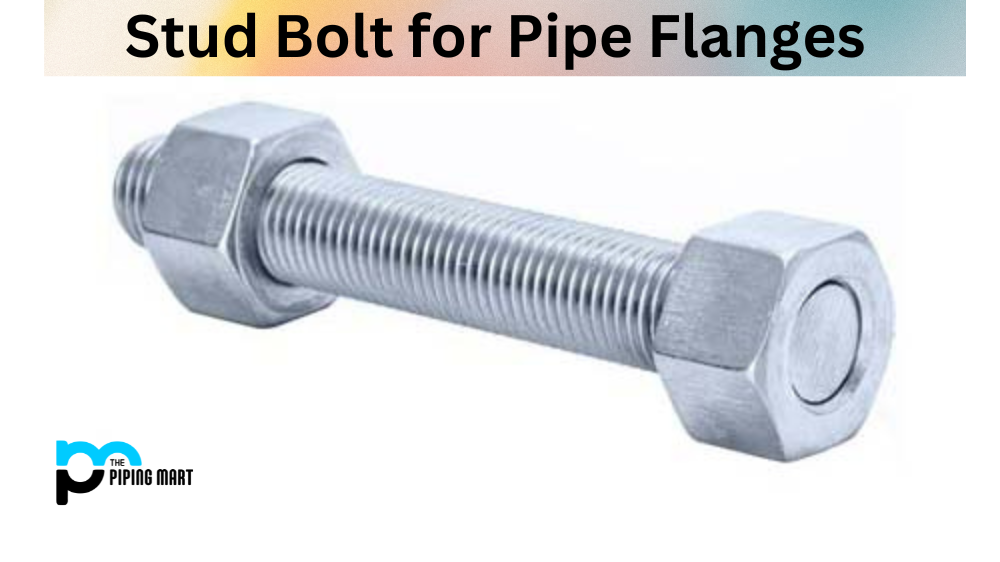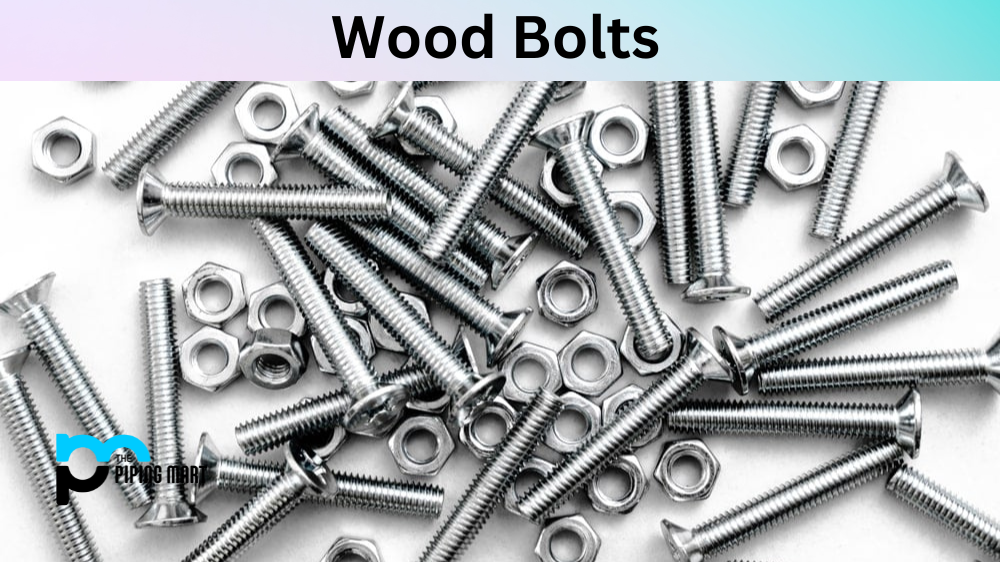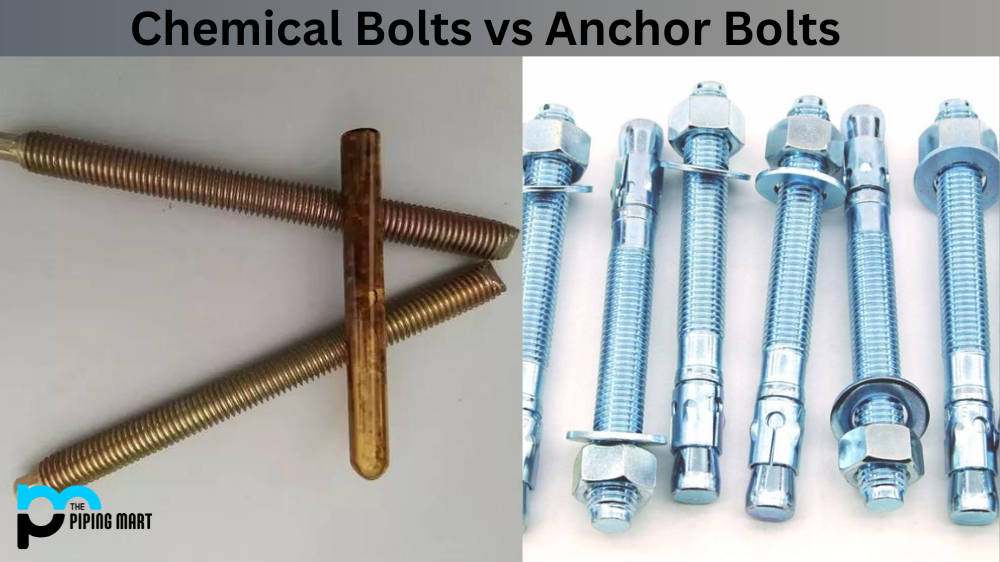Exactly what is a stud bolt? A fully threaded steel rod and two strong hexagonal steel nuts make up stud bolts for flanges. To seal a flanged joint, stud bolts are put into the flange holes and tightened. The number, length, and diameter of stud bolts required for a flanged connection are determined by the type, diameter, and rating of the flanges.
Types of Stud Bolts For Flanges
Stud Bolt and Nuts
One threaded steel rod and two (matching) hexagonal heavy steel nuts make up a stud bolt. The essential components of flanged connections are stud bolts and nuts as they provide appropriate sealing.
The hex steel nuts should be made of the same material as the threaded rod (generally, stud materials ASTM A193 match with nuts materials ASTM A194).
The ASME B16.5 standard specifies stud bolts and nuts for ASME flanges (number, size, and length of needed stud bolts) by flange diameter, pressure class, and face finish (Raised Face, Flat Face, Ring Type Joint).
Threaded Rod
A stud is a threaded rod that is placed into the holes of the mating flanges and fastened at both ends using steel nuts with a particular torque.
Thread Pitch and Thread Series of Stud Bolt
The stud is threaded as per the ASME B1.1 specifications. The steepness of the thread angle, measured in threads per inch, is referred to as “thread pitch.” Because it is fairly easy for the manufacturer to check the symmetrical thread pitch type with a “V-profile” (a 60-degree angle) as compared to the non-symmetrical type, it is the most commonly used thread. The number of threads per inch (“TPI”) applied to a single diameter is used to measure the thread series.
- Coarse thread series (UNC/UNRC): The most common type of screw, bolt, and nut is UNC. Iron, mild steel, copper and softer alloys, aluminium, and other low-strength materials are threaded with coarse threads. The coarse thread is also more resistant to corrosion and allows for faster installation.
- Fine thread series (UNF/UNRF): UNF is commonly used for precision work and where tensile strength is required (vs. the coarse thread series).
- 8-Thread series (8UN): Several ASTM standards, including A193 B7, A193 B8/B8M, and A320, include the 8-thread series (8UN) as an alternative threading method. This series is suitable for diameters of one inch and above.
All stud bolts specified by the ASTM A193 or A320 specifications utilize 8UN, which implies there are 8 threads per inch, for all diameters of 1″ and higher. Unless specified by the applicable ASTM standard, the buyer must provide the thread pitch for any other material grade.
Nuts for Stud Bolts
2 large hex steel nuts must be fastened at opposite ends of the rod to secure a stud. The stud and the steel nuts connect precisely due to the friction existing between their respective threads, by a minor stretching of the bolt, and the compression of the two joined parts. Steel nuts had a squared head in the past. Six-sided hexagonal head nuts have completely replaced the square nut with four sides because they allow for faster and more effective screwing on the stud. Nuts for petrochemical applications are tightened to a precise torque using special torque wrenches. The mechanical properties of the steel nut material must be adequate for the strength of the mated bolt. The ASME B18.2.2 specification specifies the sizes and thicknesses of heavy steel nuts for stud bolts.
Stud and Bolt Comparison
Difference between studs and bolts
A stud is a metal rod or shaft with threads on both sides and two serrated strong hexagonal nuts attached to it; a bolt is a fastener with a “built-in” head nut on one side that requires a single serrated heavy hexagonal nut.
Standards for Stud Bolt
A number of ASME standards regulate the design and manufacture of stud bolts, which are mentioned below:
- The diameter and length are covered by ASME B16.5 and ASME B16.47.
- The coarse and fine thread series are specified by ASME B1.1.
- Square and hex bolts and screws are defined under ASME B18.2.1.
- Square and hex nuts are specified in ASME B18.2.2.
- Lock washer specifications are provided in ASME B18.21.1.
- Plain washers are specified in ASME B18.22.1.
Stud bolt specifications are provided by a number of international standards, including DIN, ISO, BS, SAE, and IS.
Materials for Stud Bolt
The most often used flange material for high-temperature and high-pressure uses is ASTM A193. B7 and B7M are the most commonly used A193 material grades. ASTM A320 Gr. L7, L7A, and L7B are used for low-temperature services. Other stud bolt materials are as follows:
- ASTM A354 Gr BC, BD
- ASTM A540 Gr B21 to B24
- ASTM A193 Gr B5, B6, B8, B16, B8M, B8A, B8T, L7, B17B.
- ASTM A453 Gr 660A/B/C/D
- ASTM A913 Inconel 718
- ASTM A320 Gr L7M, L43, B8, B8A, B8T, B8MA, B8C
- ASTM A182 Gr S31803, S32205.
Flange Bolt Dimensions Chart and Stud Size in mm
Class 150 Pipe Flange Bolt Charts
| Size in Inch | Size in mm | No of Bolts | Bolt Size UNC | RF Stud Length | ISO Stud Size | Machine Bolt Length |
|---|---|---|---|---|---|---|
| Class 150 Flange | ||||||
| 1/2 | 15 | 4 | 1/2 | 55 | M14 | 50 |
| 3/4 | 20 | 4 | 1/2 | 65 | M14 | 50 |
| 1 | 25 | 4 | 1/2 | 65 | M14 | 55 |
| 1 1/4 | 32 | 4 | 1/2 | 70 | M14 | 55 |
| 1 1/2 | 40 | 4 | 1/2 | 70 | M14 | 65 |
| 2 | 50 | 4 | 5/8 | 85 | M16 | 70 |
| 2 1/2 | 65 | 4 | 5/8 | 90 | M16 | 75 |
| 3 | 80 | 4 | 5/8 | 90 | M16 | 75 |
| 3 1/2 | 90 | 8 | 5/8 | 90 | M16 | 75 |
| 4 | 100 | 8 | 5/8 | 90 | M16 | 75 |
| 5 | 125 | 8 | 3/4 | 95 | M20 | 85 |
| 6 | 150 | 8 | 3/4 | 100 | M20 | 85 |
| 8 | 200 | 8 | 3/4 | 110 | M20 | 90 |
| 10 | 250 | 12 | 7/8 | 115 | M24 | 100 |
| 12 | 300 | 12 | 7/8 | 120 | M24 | 100 |
| 14 | 350 | 12 | 1 | 135 | M27 | 115 |
| 16 | 400 | 16 | 1 | 135 | M27 | 115 |
| 18 | 450 | 16 | 1 1/8 | 145 | M30 | 125 |
| 20 | 500 | 20 | 1 1/8 | 160 | M30 | 140 |
| 24 | 600 | 20 | 1 1/4 | 170 | M33 | 150 |
Class 300 Flange Bolt Charts
| Size in Inch | Size in mm | No of Bolts | Bolt Size UNC | RF Stud Length | ISO Stud Size | Machine Bolt Length |
|---|---|---|---|---|---|---|
| Class 300 Flange | ||||||
| 1/2 | 15 | 4 | 1/2 | 65 | M14 | 55 |
| 3/4 | 20 | 4 | 5/8 | 75 | M16 | 65 |
| 1 | 25 | 4 | 5/8 | 75 | M16 | 65 |
| 1 1/4 | 32 | 4 | 5/8 | 85 | M16 | 70 |
| 1 1/2 | 40 | 4 | 3/4 | 90 | M20 | 75 |
| 2 | 50 | 8 | 5/8 | 90 | M16 | 75 |
| 2 1/2 | 65 | 8 | 3/4 | 100 | M20 | 85 |
| 3 | 80 | 8 | 3/4 | 110 | M20 | 90 |
| 3 1/2 | 90 | 8 | 3/4 | 110 | M20 | 95 |
| 4 | 100 | 8 | 3/4 | 115 | M20 | 95 |
| 5 | 125 | 8 | 3/4 | 120 | M20 | 110 |
| 6 | 150 | 12 | 3/4 | 120 | M20 | 110 |
| 8 | 200 | 12 | 7/8 | 140 | M24 | 120 |
| 10 | 250 | 16 | 1 | 160 | M27 | 140 |
| 12 | 300 | 16 | 1 1/8 | 170 | M30 | 145 |
| 14 | 350 | 20 | 1 1/8 | 180 | M30 | 160 |
| 16 | 400 | 20 | 1 1/4 | 190 | M33 | 165 |
| 18 | 450 | 24 | 1 1/4 | 195 | M33 | 170 |
| 20 | 500 | 24 | 1 1/4 | 205 | M33 | 185 |
| 24 | 600 | 24 | 1 1/2 | 230 | M39 | 205 |
Class 400 Flange Bolt and Stud Dimension Chart
| Size in Inch | Size in mm | No of Bolts | Bolt Size UNC | RF Stud Length | ISO Stud Size |
|---|---|---|---|---|---|
| Class 400 Flange | |||||
| 1/2 | 15 | 4 | 1/2 | 75 | M14 |
| 3/4 | 20 | 4 | 5/8 | 90 | M16 |
| 1 | 25 | 4 | 5/8 | 90 | M16 |
| 1 1/4 | 32 | 4 | 5/8 | 95 | M16 |
| 1 1/2 | 40 | 4 | 3/4 | 110 | M20 |
| 2 | 50 | 8 | 5/8 | 110 | M16 |
| 2 1/2 | 65 | 8 | 3/4 | 120 | M20 |
| 3 | 80 | 8 | 3/4 | 125 | M20 |
| 3 1/2 | 90 | 8 | 7/8 | 140 | M24 |
| 4 | 100 | 8 | 7/8 | 140 | M24 |
| 5 | 125 | 8 | 7/8 | 145 | M24 |
| 6 | 150 | 12 | 7/8 | 150 | M24 |
| 8 | 200 | 12 | 1 | 170 | M27 |
| 10 | 250 | 16 | 1 1/8 | 190 | M30 |
| 12 | 300 | 16 | 1 1/4 | 205 | M33 |
| 14 | 350 | 20 | 1 1/4 | 210 | M33 |
| 16 | 400 | 20 | 1 3/8 | 220 | M36 |
| 18 | 450 | 24 | 1 3/8 | 230 | M36 |
| 20 | 500 | 24 | 1 1/2 | 240 | M39 |
| 24 | 600 | 24 | 1 3/4 | 265 | M45 |
Bolt Charts for Class # 600 Flanges
| Size in Inch | Size in mm | No of Bolts | Bolt Size UNC | RF Stud Length | ISO Stud Size |
|---|---|---|---|---|---|
| Class 600 Flange | |||||
| 1/2 | 15 | 4 | 1/2 | 75 | M14 |
| 3/4 | 20 | 4 | 5/8 | 90 | M16 |
| 1 | 25 | 4 | 5/8 | 90 | M16 |
| 1 1/4 | 32 | 4 | 5/8 | 95 | M16 |
| 1 1/2 | 40 | 4 | 3/4 | 110 | M20 |
| 2 | 50 | 8 | 5/8 | 110 | M16 |
| 2 1/2 | 65 | 8 | 3/4 | 120 | M20 |
| 3 | 80 | 8 | 3/4 | 125 | M20 |
| 3 1/2 | 90 | 8 | 7/8 | 140 | M24 |
| 4 | 100 | 8 | 7/8 | 145 | M24 |
| 5 | 125 | 8 | 1 | 165 | M27 |
| 6 | 150 | 12 | 1 | 170 | M27 |
| 8 | 200 | 12 | 1 1/8 | 190 | M30 |
| 10 | 250 | 16 | 1 1/4 | 215 | M33 |
| 12 | 300 | 20 | 1 1/4 | 220 | M33 |
| 14 | 350 | 20 | 1 3/8 | 235 | M36 |
| 16 | 400 | 20 | 1 1/2 | 255 | M39 |
| 18 | 450 | 20 | 1 5/8 | 275 | M42 |
| 20 | 500 | 24 | 1 5/8 | 285 | M42 |
| 24 | 600 | 24 | 1 7/8 | 330 | M48 |
Class 900 Flange Bolt Charts
| Size in Inch | Size in mm | No of Bolts | Bolt Size UNC | RF Stud Length | ISO Stud Size |
|---|---|---|---|---|---|
| Class 900 Flange | |||||
| 1/2 | 15 | 4 | 3/4 | 110 | M20 |
| 3/4 | 20 | 4 | 3/4 | 115 | M20 |
| 1 | 25 | 4 | 7/8 | 125 | M24 |
| 1 1/4 | 32 | 4 | 7/8 | 125 | M24 |
| 1 1/2 | 40 | 4 | 1 | 140 | M27 |
| 2 | 50 | 8 | 7/8 | 145 | M24 |
| 2 1/2 | 65 | 8 | 1 | 160 | M27 |
| 3 | 80 | 8 | 7/8 | 145 | M24 |
| 4 | 100 | 8 | 1 1/8 | 170 | M30 |
| 5 | 125 | 8 | 1 1/4 | 190 | M33 |
| 6 | 150 | 12 | 1 1/8 | 190 | M30 |
| 8 | 200 | 12 | 1 3/8 | 220 | M36 |
| 10 | 250 | 16 | 1 3/8 | 235 | M36 |
| 12 | 300 | 20 | 1 3/8 | 255 | M36 |
| 14 | 350 | 20 | 1 1/2 | 275 | M39 |
| 16 | 400 | 20 | 1 5/8 | 285 | M42 |
| 18 | 450 | 20 | 1 7/8 | 325 | M48 |
| 20 | 500 | 20 | 2 | 350 | M52 |
| 24 | 600 | 20 | 2 1/2 | 440 | M64 |
Class 1500 Bolt and stud Charts
| Size in Inch | Size in mm | No of Bolts | Bolt Size UNC | RF Stud Length | ISO Stud Size |
|---|---|---|---|---|---|
| Class 1500 Flange | |||||
| 1/2 | 15 | 4 | 3/4 | 110 | M20 |
| 3/4 | 20 | 4 | 3/4 | 115 | M20 |
| 1 | 25 | 4 | 7/8 | 125 | M24 |
| 1 1/4 | 32 | 4 | 7/8 | 125 | M24 |
| 1 1/2 | 40 | 4 | 1 | 140 | M27 |
| 2 | 50 | 8 | 7/8 | 145 | M24 |
| 2 1/2 | 65 | 8 | 1 | 160 | M27 |
| 3 | 80 | 8 | 1 1/8 | 180 | M30 |
| 4 | 100 | 8 | 1 1/4 | 195 | M33 |
| 5 | 125 | 8 | 1 1/2 | 250 | M39 |
| 6 | 150 | 12 | 1 3/8 | 260 | M36 |
| 8 | 200 | 12 | 1 5/8 | 290 | M42 |
| 10 | 250 | 12 | 1 7/8 | 335 | M48 |
| 12 | 300 | 16 | 2 | 375 | M52 |
| 14 | 350 | 16 | 2 1/4 | 405 | M56 |
| 16 | 400 | 16 | 2 1/2 | 445 | M64 |
| 18 | 450 | 16 | 2 3/4 | 495 | M72 |
| 20 | 500 | 16 | 3 | 540 | M76 |
| 24 | 600 | 16 | 3 1/2 | 615 | M90 |

Pipingmart is B2B portal specializes in industrial, metal and piping products. Also, share latest information and news related to products, materials and different types grades to help business dealing in this industry.




